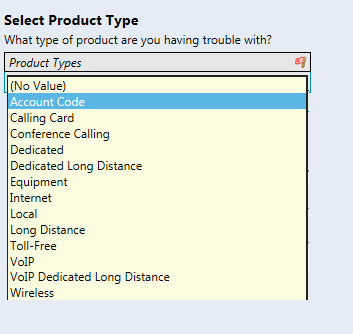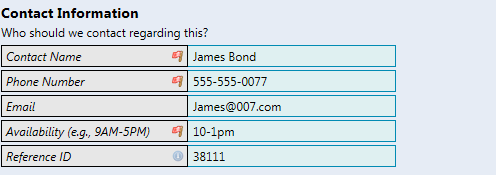2014-12 Juggernaut Release Notes
Overview
The Juggernaut release was focused primarily on launching a new Trouble Tickets entry tool available from the Customer Portal. This feature will now allow your customers to login and initiate trouble tickets from the portal vs. having to contact customer service. Customers can then track the status of the Ticket in the customer portal all the way through resolution. More details are below!
General TBS - Enhancements & Bug Fixes
15207 - Customer Portal: Add Ability for Customers to Initiate Trouble Tickets
Customers can now enter Trouble Tickets from the Customer Portal as long as the Customers security group has Add permission to the TroubleTickets_Customer module.
There are two ways to access this new feature:
- The Submit Trouble Ticket icon on the Customer Portal Home page

- From a new link on the Customer Portal Tickets page

The tool only allows tickets to be entered for active products based on the product's Active and Disconnect dates. Traditional products that do not have active or disconnect dates (e.g., Voicemail) are presumed to be Active.
For a customer to enter a new trouble ticket, they must:
- Select the Product Type. The Product Type drop-down list is limited to active product types on the account as well as an Equipment option for Traditional Product clients. Once selected, only products of that type will show in the products grid. For the Equipment selection, no products are required.

- Select all of the Products that they are having trouble with in the products grid. The product grid is filtered to active products on the product type selected. Any selected productIDs will be added to the trouble ticket description field on Save.

- Enter a description of the problem.

- Enter a callback name, phone number, email and availability. The email address can be used to send email confirmations to the customer. Additionally, a Reference ID field is available if they need to reference an existing ticket.

- Click the Submit Ticket button. A confirmation will appear along with the Ticket numbers(s).

or the following for multiple carrier tickets
- The trouble ticket(s) is also now viewable in the main trouble tickets grid.
For Internal users, the Tickets will appear in the Trouble Tickets tree like any other. For each ticket, additional Trouble Ticket fields will automatically be set. These fields and values include:
General Trouble Ticket Type:
- Integrated Product clients: the Type of Ticket will always be WorkOrder
- Traditional Product clients: the Type of Ticket will be driven by the selected Product Type. Here's the mapping:
-
Traditional Product Type Trouble Ticket Result Type Account Code Long Distance Calling Card Long Distance Conference Calling Long Distance Dedicated Dedicated Dedicated Long Distance Dedicated Dedicated Toll-Free Dedicated Equipment Work Order Internet Internet Local or VoIP Local Local Long Distance or VoIP Long Distance Long Distance Toll-Free or VoIP Toll-Free Toll-Free Voicemail Work Order Wireless Wireless
Open Date/Time: - Set to the time the ticket is submitted.
Origin (indicates whether the customer initiated the ticket or if it was internal)
- Set to 1, which means "EnteredByCustomer". In addition to being a good field for reporting purposes, this field provides a way to send emails based on tickets entered from this new page.
- Important: At release time, a Metric Action is being created so that trouble tickets created from the customer portal trigger an email to either the AssignedTo (if setup to default this value) or the Trouble Repair Email address on the customer base. Additionally, if the customer provides an email in the Contact Information section, a separate Metric Action record can be created to trigger a confirmation email to the customer using this email address.
15207 - Additional changes to the Trouble Ticket screen for internal users
In order to support the changes for the new Customer Portal Trouble Ticket entry feature, some changes have been made to each of the Trouble Ticket screens. Please be sure to review the changes below as well as note the new screenshots of each trouble ticket type available in the Trouble Ticket Screen documentation.
- Site Contact, Site Callback and Site Email (new field) are now available on all ticket types
- The Repair / Dispatch section, including the Access Hours area is now always available on all ticket types
- Customer Assigned ID has been relabeled to Customer Reference ID
- Service Type selection is now available on all ticket types
- Carrier information has been added to the internal Trouble Tickets grid & all ticket types
- Submitted To Center is now available on all ticket types
- Open Date/Time is no longer prefilled with the same information as Entry Date. This allows this field to be used for reporting of alternative dates such as the date opened with a carrier.
21068 - Add flag to TBS to trigger one column invoice
A new "Single Column Invoice" flag has been added to the Account Settings -> Invoicing Tab.
This defaults to "N", meaning that the invoice will be produced as normal with both reports being presented in Two columns as normal.
Setting this flag to "Y" will cause the invoice reports to be produced with all reports being presented in One column.
This flag only impacts invoice reports starting on Page 3 of the PTT Invoice. Pages 1 & 2 will not be affected by this invoice flag. Example Page 3:
It is important to note that producing Single Column invoices may cause invoices to become significantly larger. As a result, this could cause a dramatic rise in printing and postage costs. Additionally, this only applies to the PTT Internal Invoice.
Integrated Products - Enhancements & Bug Fixes
23162 - Integrated Product - Equipment Product Field Adds Development
Additional, auxiliary information can now be stored on products with a Product Class of "Device." Product Classes are selected at the Product Type level.

| Field | Definition | Notes |
| Serial ID | Serial Number on the Device or Equipment | |
| Storage Area | Location for storage. i.e., Warehouse |
The options can be maintained by choosing Drop Down Menus from System Administration.
|
| Stock Date | The date the device was put into stock | |
| Supplier | The supplier name or vendor name |
The options can be maintained by choosing Drop Down Menus from System Administration.
|
| Reference ID | Reference Number for the Device | |
| Manufacturer | Maker or Manufacturer of the Device |
The options can be maintained by choosing Drop Down Menus from System Administration.
|
| Model | Model name of the Device |
The options can be maintained by choosing Drop Down Menus from System Administration.
|
| Firmware Version | Version of the Firmware installed on the Device |

